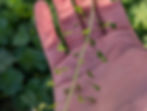Everything you need to know about foraging shepherd's purse. First, we will cover identification, range and habitats, and some potential look-alikes before diving into harvesting and eating it!

Description
Shepherd’s purse, Capsella bursa-pastoris, is a small annual in the mustard family. It begins as a basal rosette with deeply lobed, lanceolate leaves. The lobes are often slightly pinched, giving them a unique look.

It quickly bolts, sending up a flowering stalk with smaller, non-lobed leaves. The flower buds are in tiny clusters that have some resemblance to broccoli (a mustard relative). They open to reveal small, four-petaled, white flowers with the characteristic six stamens of most mustard plants; four stamens are tall, and two are short.

The flowers quickly become flat, heart-shaped seed pods, which give it the name shepherd’s purse because they resemble a bag or purse. Each seed pod holds several tiny brown seeds. Shepherd's purse will continue to produce flowers and seed pods throughout the growing season.

Range & Habitats
Shepherd’s purse is native to Eastern Europe and Asia but is now one of the most common plants in the world. It is considered a weed throughout much of its naturalized range where it tends to grow in areas of human disturbance. It is a common yard and garden weed is often pervasive in agricultural settings.

Potential Look-alikes
The information in the description above should be enough to identify shepherd's purse properly. However, look-alike information is regularly requested, so here are some possible species that could be confused with shepherd's purse. This list is not comprehensive and may not be relevant to your region. Remember only to eat wild foods once you're 100% confident in your identification and comfortable with trying something new.
Other species of mustard before they flower. All are edible, though some are bitter or strong-tasting.
Dandelion, chicory, and other plants with lobed, lance-shaped leaves in a basal rosette.

Join The Forage Colorado Newsletter!
Sign up for our email newsletter to get seasonal foraging tips, wild food classes,
early access to foraging events, and more!
Shepherd's Purse Edibility & Harvesting
Like all mustards, the entire plant can be eaten! Shepherd’s purse is one of the mustards that tastes good and lacks many bitter or hot flavors that can be common in some other mustard plants. It is cultivated in parts of Asia for its edible leaves and roots. In Japan, it is one of seven plants used in an annual tradition known as the Festival of the Seven Herbs. Like any mustard, once the plant flowers, its flavor can become a little more mustardy or hot, but it is still edible. The leaves are my favorite part and make a nice cooked mustard green. The best leaves come from wetter soils with high nutrients that allow them to grow large! To harvest, pinch or snip leaves away from the plant, or pull up the entire rosette and clean the roots and leaves while all together.
The tender flower bud and flower clusters can be picked from the plant and eaten raw or cooked. The seed pods make an interesting, albeit tiny, pickle or caper and can also be eaten raw or mixed with pretty much any dish to add some mustard flavors. To harvest, pick the tender, green pods off the flower stalk. Any pods that have started to turn yellow will be tough. Once the seed pods dry out, the tiny seeds can be used to make a mustard condiment, though it would be labor intensive. To collect the seeds, harvest the flower stalk, place it in a paper bag, and strip off the dried seed pods. These seed pods can then be broken up to release the seeds. The chaff can be gently separated from the seeds with a small amount of airflow or by rolling the seeds away from the chaff on a baking sheet.

Foraging Calendar
To learn more about the best seasons to harvest this species and many other wild foods, check out my Foraging Calendar & Wild Food Database! You can try the demo version to learn more, and join my Patreon to gain full access to the Foraging Calendar and other exclusive perks! Joining is the best way to support all the work I put into my content and website to help you learn about foraging! Thank you for checking it out!





